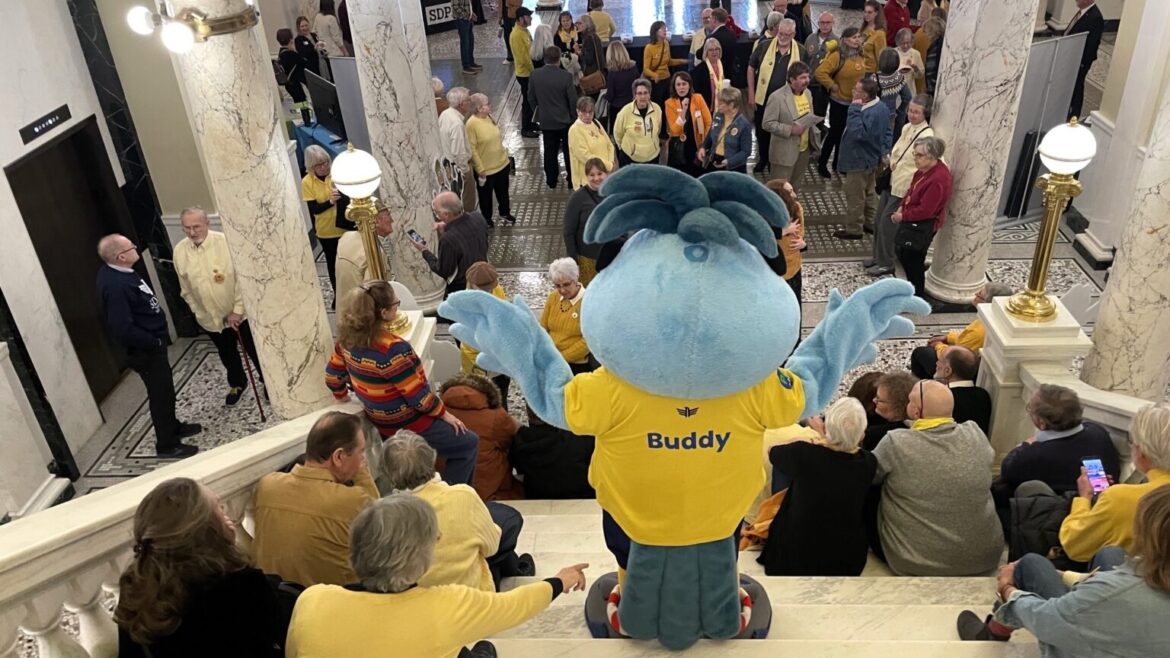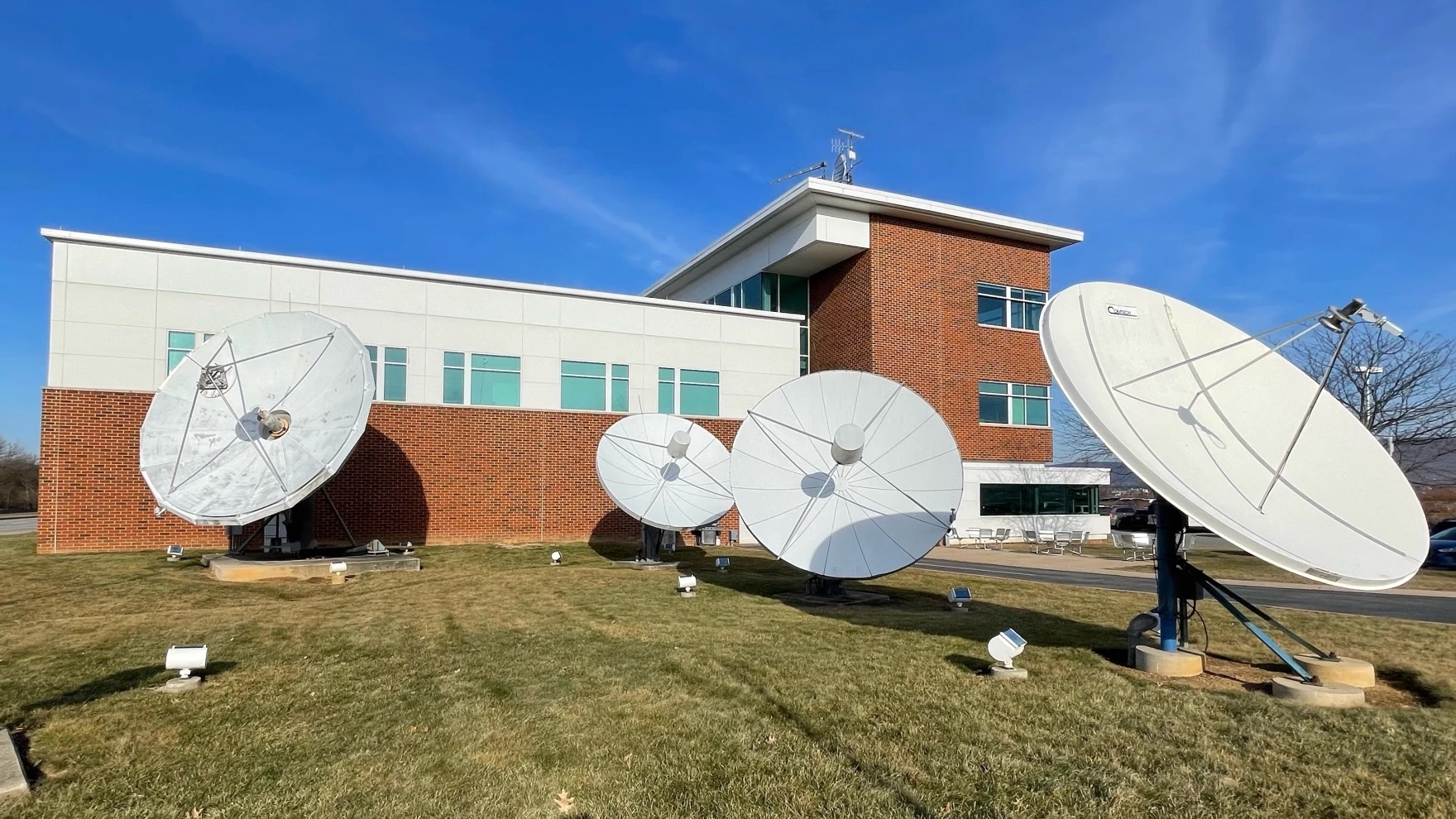Busloads of South Dakota Public Broadcasting supporters make case to avoid $3.6M state budget cut

Seth Tupper / South Dakota Searchlight
South Dakota Public Broadcasting’s mascot, Buddy, waves to a crowd of supporters gathered Friday at the Capitol Rotunda in Pierre.
PIERRE — Supporters of South Dakota Public Broadcasting made their pitch Friday at the Capitol to avoid a $3.6 million budget cut that they said would undermine public safety, government transparency, education, high school activities and local storytelling.
The state agency receives state and federal funding, along with money raised by its affiliated nonprofit, the Friends of SDPB. Friends CEO Ryan Howlett told members of the Legislature’s budget committee that the state funding cut would imperil federal matching funds, and the combined reduction in state and federal funding would trigger “grim” local programming cuts that would hinder fundraising.
“It’s not just a $3.6 million budget cut,” Howlett said. “It’s much more substantial than that because of the domino effect.”
He estimated that the combined effect of the lost state, federal and privately raised money would shrink the organization’s total budget from $11 million to $4 million and reduce its workforce from 76 to 26.
That would effectively diminish the network to a pass-through for national programming on radio and television, Howlett said. Locally produced shows would end, and the organization would no longer be able to broadcast dozens of state high school events ranging from all-state orchestra to football championship games.
It’s SDPB’s willingness and ability to cover all 40 to 50 state-level high school events — not just a few of the popular sports — that makes the agency a vital partner of the South Dakota High School Activities Association, said Executive Director Dan Swartos.
“We’re not going to find another over-air partner who is able to do that,” Swartos said.
Lawmakers learned about a lesser-known aspect of SDPB’s work from its director of engineering and operations, Severn Ashes. He explained that SDPB’s statewide network of broadcast towers is a backbone for the state and national Emergency Alert System, with alerts received and triggered by SDPB and then relayed by other broadcasting systems.
If the budget cut is adopted, Ashes said, “the state would have to find an alternative” for the system.
The network also livestreams, records and archives every legislative committee hearing and floor session of the state House and Senate, plus the meetings of dozens of state boards and commissions. The agency would not be able to operate that system with its reduced funding, Howlett said.
Kayla Klein, representing the Early Learner South Dakota advocacy group, testified about the value of SDPB’s free educational programming and resources for parents, homeschoolers and child care providers. She drew smiles in the committee room with a story about her young son using something he learned on the PBS show Daniel Tiger’s Neighborhood to help her through a difficult day: “He turned to me and said, ‘Mom: When you feel so mad that you want to roar, take a deep breath and count to four.’”
Eric Erickson, VP of corporate partnerships for the Friends of SDPB, said the educational programming, the high school activities broadcasts, the podcasts and documentaries that SDPB produces about South Dakota news and history, and other SDPB programming are worthy of state support.
“The stories we do are not profitable — they’re important,” he said.
The hearing was one of many that the Legislature’s Joint Appropriations Committee conducts as it works to prepare the annual state budget. Members listened and asked questions but took no action and made no public comments indicating support or opposition to the SDPB budget cut.
This year’s legislative session began last month and continues through mid-March. The budget bill typically takes most of the session to draft, with many decisions occurring in the final weeks and days of the session.

Republican former Gov. Kristi Noem proposed the public broadcasting cut in December before she left last month to become the secretary of the federal Department of Homeland Security. The state is facing a difficult budget year due to declining sales tax revenue, the depletion of pandemic aid from the federal government and rising Medicaid costs.
New Gov. Larry Rhoden, who was Noem’s lieutenant governor, acknowledged last month in a speech to the Legislature that “there is concern about some specifics in the budget proposal.”
“I will work with our budget office to try to restore some of those cuts,” he said at the time, without going into specifics.
After Friday’s budget hearing, SDPB leaders gathered with two busloads of supporters for a picture on the Capitol Rotunda steps. Rhoden’s lieutenant governor, Tony Venhuizen, joined them.
In a brief interview with South Dakota Searchlight, Venhuizen said revenue projections are looking a little worse than when Noem proposed her budget.
“In a tough budget year, you have to prioritize and make tradeoffs, and there are all sorts of cuts being proposed that nobody really wants to make,” Venhuizen said. “We’ll just see what happens over the next couple of weeks.”






